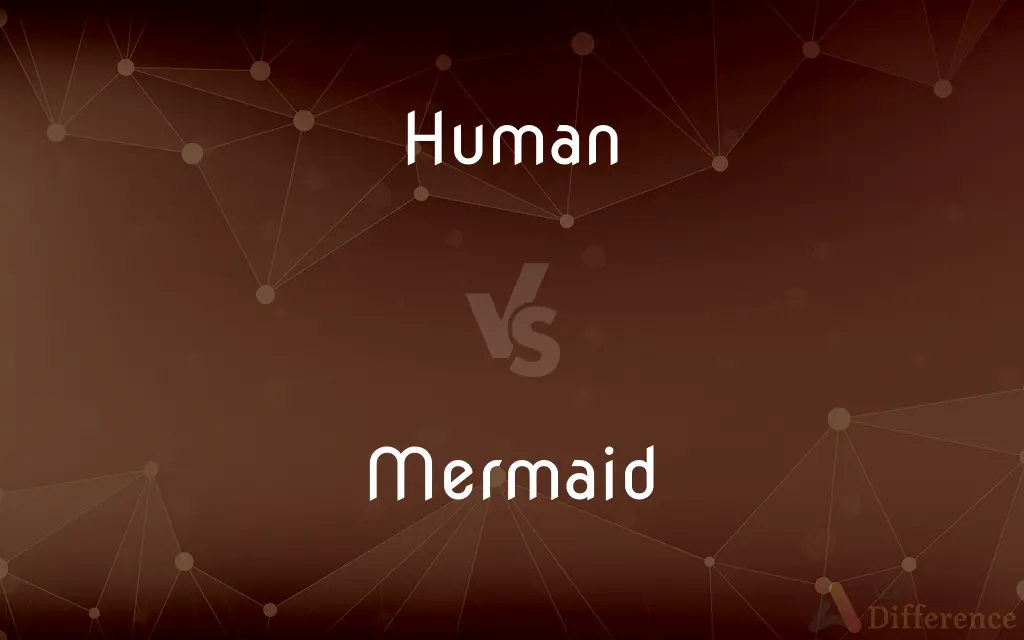Human vs. Mermaid — What's the Difference?
By Fiza Rafique & Maham Liaqat — Updated on March 14, 2024
Humans are real, bipedal beings with advanced cognitive abilities, while mermaids are mythical creatures depicted with a human upper body and a fish-like lower body.

Difference Between Human and Mermaid
Table of Contents
ADVERTISEMENT
Key Differences
Humans belong to the species Homo sapiens, characterized by their bipedal locomotion, opposable thumbs, and highly developed brains, enabling complex thought and language. Mermaids, in contrast, are creatures of folklore, often depicted with the upper body of a human and the lower body of a fish, embodying the mystery and allure of the ocean.
Culturally, humans have a diverse range of societies, languages, and traditions, shaped by thousands of years of history and evolution. Mermaids, however, are often portrayed in myths and stories as enchanting beings who can be benevolent or malevolent, with their tales varying widely across different cultures.
Physiologically, humans are adapted to live on land, with body structures suited for walking, running, and manipulating objects. Mermaids, as imagined, would be adapted for aquatic life, with their fish-like tails suggesting an ability to live and move efficiently in water.
In literature and media, humans are represented in all forms of storytelling, reflecting the full spectrum of human experience. Mermaids appear in folklore, fairy tales, and modern fantasy stories, often serving as symbols of the unexplored and mystical aspects of the ocean.
Comparison Chart
Nature
Real, biological beings.
Mythical, folklore creatures.
ADVERTISEMENT
Appearance
Bipedal, with two legs and opposable thumbs.
Human upper body, fish-like lower body.
Habitat
Terrestrial, adapted to a wide range of environments.
Imagined to live in oceans or bodies of water.
Abilities
Advanced cognitive skills, language, tool use.
Often depicted with abilities like singing to enchant and swimming adeptly.
Cultural Significance
Central to all aspects of reality and history.
Feature in folklore and fantasy, symbolizing mystery and allure of the sea.
Compare with Definitions
Human
A member of the species Homo sapiens, characterized by bipedalism and high cognitive ability.
Humans have populated nearly every part of the Earth.
Mermaid
A mythical sea creature with a human upper body and a fish's tail.
Mermaid legends are found in many cultures around the world.
Human
Known for their ability to create complex languages and cultures.
The diversity among human cultures reflects a wide range of adaptations to different environments.
Mermaid
Symbolizes the connection and boundary between the human world and the mysterious marine world.
Mermaids are often seen as guardians or spirits of the sea in folklore.
Human
Social beings with a strong emphasis on community and relationships.
Human societies are built around complex social structures and relationships.
Mermaid
Often depicted with the ability to enchant humans, particularly sailors, with their beauty and singing.
Sailors in folklore often spoke of being mesmerized by mermaid songs.
Human
Possess physical versatility that supports a wide range of activities.
Humans engage in varied physical activities, from running to intricate handiwork.
Mermaid
Variations of mermaid myths include different powers and attributes, from benign to malevolent.
Some tales describe mermaids as benevolent creatures who aid sailors, while others portray them as perilous beings.
Human
Capable of creating and using tools to manipulate their environment.
From stone tools to computers, human ingenuity has shaped their development.
Mermaid
Inspires a wide range of artistic and literary works, from ancient folklore to contemporary fantasy.
Mermaids continue to be a popular subject in books, movies, and art, captivating audiences with their mystique.
Human
Relating to or characteristic of humankind
The human body
The complex nature of the human mind
Mermaid
In folklore, a mermaid is an aquatic creature with the head and upper body of a female human and the tail of a fish. Mermaids appear in the folklore of many cultures worldwide, including Europe, Asia, and Africa.
Human
A human being.
Mermaid
Coloured a brilliant turquoise.
Mermaid smoothie
Human
Humans (Homo sapiens) are the most abundant and widespread species of primates, characterized by bipedality and large, complex brains enabling the development of advanced tools, culture and language. Humans are highly social beings and tend to live in complex social structures composed of many cooperating and competing groups, from families and kinship networks to political states.
Mermaid
A legendary sea creature having the head and upper body of a woman and the tail of a fish.
Human
A member of the primate genus Homo, especially a member of the species Homo sapiens, distinguished from other apes by a large brain and the capacity for speech.
Mermaid
A mythological Category:en:Mythological_creatures creature with a woman's head and upper body, and a tail of a fish.
Human
A person
The extraordinary humans who explored Antarctica.
Mermaid
(obsolete) A prostitute.
Human
Of, relating to, or characteristic of humans
The course of human events.
The human race.
Mermaid
A fabled marine creature, typically represented as having the upper part like that of a woman, and the lower like a fish; a sea nymph, sea woman, or woman fish.
Human
Having or showing those positive aspects of nature and character regarded as distinguishing humans from other animals
An act of human kindness.
Mermaid
Half woman and half fish; lives in the sea
Human
Subject to or indicative of the weaknesses, imperfections, and fragility associated with humans
A mistake that shows he's only human.
Human frailty.
Human
Having the form of a human.
Human
Made up of humans
Formed a human bridge across the ice.
Human
(notcomp) Of or belonging to the species Homo sapiens or its closest relatives.
Human
(comparable) Having the nature or attributes of a human being.
To err is human; to forgive, divine.
Human
(narrowly) The tallest, most abundant and most intelligent of primates; Homo sapiens.
Humans share common ancestors with other apes.
Human
(broadly) Any hominid of the genus Homo.
Human
(rare) To behave as or become, or to cause to behave as or become, a human.
Human
Belonging to man or mankind; having the qualities or attributes of a man; of or pertaining to man or to the race of man; as, a human voice; human shape; human nature; human sacrifices.
To err is human; to forgive, divine.
Human
A human being.
Sprung of humans that inhabit earth.
We humans often find ourselves in strange position.
Human
A human being;
There was too much for one person to do
Human
Any living or extinct member of the family Hominidae
Human
Characteristic of humanity;
Human nature
Human
Relating to a person;
The experiment was conducted on 6 monkeys and 2 human subjects
Human
Having human form or attributes as opposed to those of animals or divine beings;
Human beings
The human body
Human kindness
Human frailty
Common Curiosities
Are there any real animals that could have inspired mermaid myths?
Manatees and dugongs, with their human-like features when viewed from a distance, are thought to have inspired some mermaid legends among sailors.
What role do mermaids play in storytelling and art?
Mermaids often serve as symbols of the ocean's enchantment and mystery in storytelling and art, ranging from cautionary tales to romanticized portrayals.
How do humans and mermaids differ in their habitat preferences?
Humans are adapted to a wide range of terrestrial environments, while mermaids are mythically associated with aquatic habitats, especially the ocean.
What can the fascination with mermaids tell us about human culture?
The fascination with mermaids reflects human curiosity and imaginative exploration of the unknown, particularly the mysteries of the sea and the boundaries between human and nature.
What fundamentally distinguishes humans from mermaids?
Humans are real, biological beings with advanced cognitive abilities and a terrestrial lifestyle, while mermaids are mythical creatures with a human upper body and a fish-like lower body, imagined to live in water.
Can mermaids be considered a part of human culture?
Yes, mermaids are a significant part of human folklore and mythology, reflecting cultural perceptions of the ocean's mystery and allure.
How does the concept of mermaids influence modern media?
Mermaids continue to be popular in modern media, inspiring movies, books, and TV shows that explore their mythical nature and imagined interactions with humans.
Do mermaid myths serve any purpose in understanding human psychology?
Mermaid myths can provide insights into human psychology by revealing how people conceptualize and mythologize the natural world, including fears, desires, and the unknown.
How do environmental adaptations of humans contrast with the imagined adaptations of mermaids?
Humans have adapted to diverse environments through physical and cultural evolution, while mermaids are imagined to be perfectly suited for life in the ocean, embodying an idealized relationship with the marine world.
How has the portrayal of mermaids evolved in contemporary culture?
The portrayal of mermaids has evolved to include a wider range of narratives, from traditional folklore to modern reinterpretations that challenge or expand upon ancient myths.
Are mermaid myths found in multiple cultures around the world?
Yes, mermaid myths and similar aquatic humanoid creatures are found in the folklore of many cultures worldwide, each with unique characteristics and stories.
Are there any lessons or moral themes commonly associated with mermaid stories?
Mermaid stories often carry moral themes related to respect for nature, the consequences of curiosity, and the complexities of interaction between different worlds or beings.
How do the physical abilities of humans compare to those imagined for mermaids?
Humans have physical abilities suited for terrestrial life, including walking and tool use, while mermaids are imagined to have excellent swimming capabilities and sometimes magical powers related to the sea.
What similarities do humans and mermaids share in folklore?
In folklore, both humans and mermaids often exhibit social behaviors and emotions, with mermaids sometimes engaging with humans in complex ways that mirror human social interactions.
How do artistic representations of mermaids differ across cultures?
Artistic representations of mermaids vary widely across cultures, reflecting different aesthetic preferences, symbolic meanings, and interpretations of these mythical beings within each cultural context.
Share Your Discovery

Previous Comparison
Passcode vs. Passkey
Next Comparison
Defiant vs. SubmissiveAuthor Spotlight
Written by
Fiza RafiqueFiza Rafique is a skilled content writer at AskDifference.com, where she meticulously refines and enhances written pieces. Drawing from her vast editorial expertise, Fiza ensures clarity, accuracy, and precision in every article. Passionate about language, she continually seeks to elevate the quality of content for readers worldwide.
Co-written by
Maham Liaqat













































